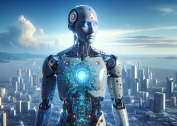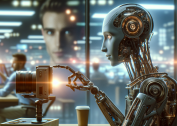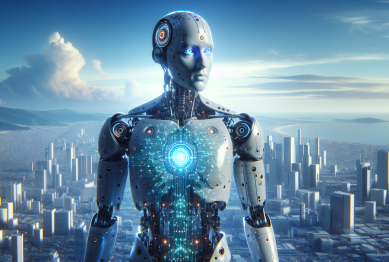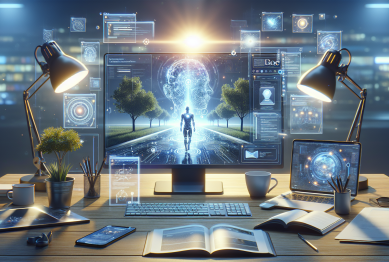Artificial intelligence is reshaping how people work, connect, and experience daily life. This in-depth guide explores practical ways AI is being used, new breakthroughs, and what emerging trends might mean for individuals and communities. Dive in to learn how technology influences modern routines—no jargon, just real stories and expert perspectives on AI for everyone.
Unlocking AI in Everyday Life
When many think of artificial intelligence, high-tech labs and self-driving cars often come to mind. Yet, AI for everyone means something much more everyday—think voice assistants helping with reminders or search engines predicting what you want to know. Around the world, smart algorithms quietly boost email filters, suggest entertainment, and even help identify spam calls. All of this adds subtle convenience, streamlining many activities that once took up more time.
Look closer and these smart assistants are everywhere. A favorite song might finish, and a playlist continues, or shopping platforms show products that perfectly fit a wish list. These suggestions aren’t magic. They’re powered by learning systems that adapt over time, finding useful patterns in huge amounts of data. For those curious about what happens behind the scenes, it’s a blend of math, code, and continual improvement, guided by real interactions.
This everyday technology changes expectations. Tasks that required hours are handled in minutes or less. Even older adults unfamiliar with new devices benefit as interfaces get simpler, sometimes even operated by voice. The goal of modern AI isn’t just to appear smart, it’s to truly help, offering access and answers to more people in more ways than before (Source: https://www.nibib.nih.gov/science-education/science-topics/artificial-intelligence).
AI also tackles invisible processes. In healthcare, smart image analysis finds signs of illness; in banking, credit decisions are streamlined; in weather predictions, patterns emerge earlier. These background improvements make daily life safer, more predictable, and sometimes even less costly. By spotting fraud or unusual activity, AI brings peace of mind to personal finance.
Interestingly, the rise of smart technologies also fuels creative work. AI programs assist in writing, composing music, or crafting digital art. For beginners and experts, these tools offer new ways to express ideas. They lower barriers, letting more people participate in creativity and problem-solving, regardless of background or skill level.
The practical side of this intelligence can be surprising. It supports everything from scheduling meetings to checking grammar or mapping efficient routes through busy cities. The story of AI for everyone is less about robots and more about digital companions making life’s details smoother (Source: https://www.smithsonianmag.com/innovation/ai-explained-simply-180980224/).
With so many touchpoints, concerns about privacy and fair use emerge. Thoughtful design and transparent practices are growing fields in AI development. Developers and researchers increasingly discuss how to create responsible, equitable, and understandable technology. While AI’s reach expands, protecting personal data and ensuring honest decision-making remain top priorities.
Readers might wonder—what’s next for such pervasive tech? As more devices connect and learn from interactions, the ‘intelligence’ around us becomes both familiar and powerful. The ongoing conversation is about balance: using digital tools for good, ensuring everyone benefits, and watching for shifts in what feels private or public. Explore further insights about the importance of trust as AI continues to grow (Source: https://ai.google/responsibility/principles/).
The Engine Behind AI Smarts
It’s not all mysterious. Most artificial intelligence works because of machine learning—a method where computers spot patterns across thousands or millions of examples. A baby learns ‘cat’ or ‘dog’ through comparison and correction. AI learns similarly, though with more data and fewer naps. At the heart of many breakthroughs are neural networks: software “brains” inspired (loosely) by how actual brains work.
These networks connect digital ‘neurons’ that sort, rank, and sift through data. For instance, image recognition tools ‘see’ billions of photos and gradually fine-tune what makes a banana yellow or a mountain steep. Over time, such systems become remarkably accurate (Source: https://www.nature.com/articles/d41586-023-02081-z).
One fascinating twist is that some AI systems “imagine” potential scenarios. Called generative adversarial networks, or GANs, these tools dream up new images or sounds after ‘learning’ from real ones. Their applications extend to video games, design, and even realistic photo editing. Blurring the line between authentic and artificial, such advances raise new ethical and creative questions.
The challenge for engineers is not just building brighter AI. It’s keeping transparency and intention at the center: not just how the system works, but why decisions or recommendations are made. As users grow savvier, demanding explanations becomes part of the new digital normal.
Human-AI Partnerships at Work
AI for everyone thrives on collaboration, not replacement. In healthcare, radiologists team with AI-assisted imaging for earlier detection of diseases, allowing doctors to make faster, better-informed decisions (Source: https://www.nibib.nih.gov/science-education/science-topics/artificial-intelligence). In classrooms, teaching assistants powered by AI offer tailored lessons, addressing each student’s needs. Offices use automation to reduce paperwork, freeing up time for creative or strategic projects.
This isn’t about losing jobs to machines. Instead, workers often find their tasks evolving. Repetitive or data-heavy chores shift toward digital assistants, while people focus more on empathy, judgment, and critical thinking—qualities that define strong teams. The mix of human intuition and algorithmic efficiency leads to smarter outcomes.
In creative industries, AI collaborations produce novel artworks, synthesize new musical styles, or speed up video editing. Writers experiment with digital co-authors, and designers explore themes generated by algorithms. Far from being a threat, this new creative partnership opens unexplored avenues, making artistic exploration more accessible than ever.
Another growing trend is professional upskilling. Organizations invest in AI literacy programs, ensuring employees not only understand smart tools but also help shape their use cases. Many universities and free online platforms offer courses in practical AI, covering subjects from basics to advanced ethics (Source: https://www.edx.org/learn/artificial-intelligence).
Relying on automated systems also means preparing for new responsibilities, such as monitoring outcomes and correcting bias. Multidisciplinary teams—engineers, ethicists, and domain experts—work together to validate and refine AI processes. The future isn’t about machines taking over; it’s about finding new ways for people and digital minds to solve complex problems, hand in hand.
Ultimately, technology doesn’t operate in a vacuum. Human oversight, values, and goals define every breakthrough. The art of successful collaboration is in knowing what to delegate to code, and when to trust human instincts.
AI and the Ethics of Everyday Decision-Making
As AI becomes more available, ethical challenges grow more visible. How should smart systems decide who gets a loan, or which news headlines to display? Fairness, transparency, and data protection become essential. Tech companies and watchdog groups work together to draft principles that guide responsible development (Source: https://ai.google/responsibility/principles/).
Decision-making by AI is rarely perfect. An algorithm trained mostly on one type of data may miss important details for someone outside the main group. This can result in unfair outcomes or reinforce old stereotypes, so diverse datasets and conscious bias checks are a must.
For consumers, laws and guidelines about privacy help clarify who owns their information and how it’s used. With big tech transitions, awareness is key—people need a way to question, opt out, or track what’s captured and analyzed in their digital wake.
The rapid spread of AI makes it easy to overlook unintended consequences. Facial recognition systems might sort through images to speed up airport security but could also risk privacy if not tightly managed. Advocates call for stronger protections and independent review boards, ensuring smart technology earns the trust of its users.
Transparent AI systems become more common as public pressure rises. New rules, like the European Union’s AI Act, focus on explainability—a user should understand how and why a decision is made, not just the outcome. Moving forward, trust rests on open processes and continual public engagement (Source: https://www.brookings.edu/articles/artificial-intelligence-ethics-frameworks/).
The call for responsible AI is global. Advocacy organizations, industry groups, and research institutes regularly publish open reports or guidelines to highlight issues and suggest improvements. Being transparent about capabilities, limits, and potential misuse of AI makes adopting new technology safer and fairer for everyone.
As conversations grow louder, everyday users play an increasingly important role—asking questions, reporting problems, and demanding better choices from service providers and device makers alike (Source: https://www.weforum.org/agenda/2023/02/ethical-ai-principles-for-training-large-language-models/).
Emerging Frontiers in AI Innovation
This year’s breakthroughs might involve fields people haven’t quite imagined. Quantum computing—the attempt to use strange atomic effects to supercharge calculation—could push next-generation AI even further (Source: https://www.ibm.com/topics/quantum-computing). Combining advanced AI models with quantum power could one day solve scientific and logistical puzzles beyond today’s reach.
Another growth area is “multimodal” AI, which blends different kinds of data at once. These new models use text, images, sound, and even video together for deeper understanding. They help robots interpret their surroundings, improve accessibility tools, or customize virtual assistants for every situation.
Healthcare and environmental science stand to benefit most from emerging AI. Smart tools predict disease outbreaks, track climate shifts, and recommend more sustainable energy strategies. The ability to sift through countless records quickly means better preparedness and more targeted responses.
A closer look at current research shows AI-powered simulations test new materials, medicines, and public health scenarios. Collaboration across borders and disciplines fuels rapid discovery, breaking barriers that once slowed scientific progress (Source: https://www.nature.com/articles/d41586-023-02081-z).
Startups and Fortune 500 companies alike are investing in research that blends AI and robotics in new ways. Shared goals? Safer workplaces, more efficient factories, and new learning environments. Advances in natural language processing let computers ‘understand’ intricate questions, turning technical documents into simple overviews for any reader.
This isn’t just a story for tech buffs. Every breakthrough in AI has trickle-down effects—new accessibility features, more personalized education tools, or even creative aids for writers and artists. Curiosity, careful engineering, and wide collaboration fuel an era of possibility in the AI world.
Empowering Communities with Accessible AI
When AI reaches everyone, the impact stretches beyond convenience. Nonprofits and civic groups use AI-powered mapping to target food aid, map disaster response, and connect underserved communities to resources. Open-source platforms and educational resources help new voices join the digital conversation, breaking down cost or knowledge barriers that once stood in the way (Source: https://datascience.nih.gov/ai-nih).
In classrooms, smart learning platforms adjust for language, pace, and strength—supporting diverse needs. Librarians and public officials use predictive analytics to anticipate needs, optimize budgets, and improve services for those who need it most.
Science communication finds powerful allies in artificial intelligence. Tools that summarize large articles, translate findings, and illustrate research expand public access to new discoveries. AI amplifies citizen science projects, letting volunteers around the world sift through data and spot patterns in ways that were once impossible.
Accessibility remains a driving force for innovation. From speech recognition for those with disabilities to real-time translation that bridges language gaps, small improvements yield outsized benefits for vulnerable groups. AI for everyone aims to make the pursuit of knowledge fairer, broader, and more inclusive.
Building accessible AI presents real challenges, of course. Tools must be user-friendly, culturally aware, and safeguarded against misuse or error. Ongoing public input, training, and feedback loops ensure that smart technology evolves to fit people—not the other way around.
The greatest leaps come when individuals, organizations, and policymakers work together for the common good. By focusing on openness and community participation, the coming decade could see truly universal gains from AI’s promise.
References
1. National Institute of Biomedical Imaging and Bioengineering. (n.d.). Artificial Intelligence. Retrieved from https://www.nibib.nih.gov/science-education/science-topics/artificial-intelligence
2. Smithsonian Institution. (2023). AI Explained Simply. Retrieved from https://www.smithsonianmag.com/innovation/ai-explained-simply-180980224/
3. Google AI. (n.d.). AI at Google: Our Principles. Retrieved from https://ai.google/responsibility/principles/
4. edX. (n.d.). Artificial Intelligence Courses. Retrieved from https://www.edx.org/learn/artificial-intelligence
5. World Economic Forum. (2023). Ethical AI Principles for Training Large Language Models. Retrieved from https://www.weforum.org/agenda/2023/02/ethical-ai-principles-for-training-large-language-models/
6. National Institutes of Health. (2023). Artificial Intelligence at NIH. Retrieved from https://datascience.nih.gov/ai-nih









